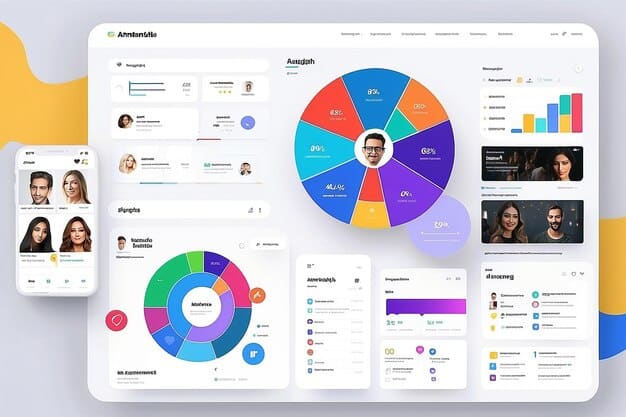Enhance Customer Loyalty: The Impact of Personalization

The impact of personalization on customer loyalty is significant, as customized experiences foster stronger connections. By tailoring interactions to individual needs and preferences, businesses can create lasting relationships and keep customers returning.
In today’s competitive market, retaining customers is just as crucial as attracting new ones. One of the most effective strategies for fostering customer loyalty is through personalization. By understanding individual customer needs and preferences, businesses can create customized experiences that resonate, leading to increased satisfaction and long-term loyalty. Let’s explore the impact of personalization on customer loyalty and how you can implement it to keep your customers coming back.
Understanding the Core of Personalization
Personalization is more than just adding a customer’s name to an email. It’s about understanding their unique needs, preferences, and past interactions to deliver relevant and valuable experiences. This approach not only makes customers feel valued but also streamlines their journey, making it easier and more enjoyable to engage with your brand.
Why Personalization Matters
Personalization fosters a sense of connection and understanding between a customer and a brand. When customers feel understood and valued, they are more likely to develop a strong sense of loyalty. This, in turn, leads to repeat purchases, positive word-of-mouth referrals, and a stronger overall relationship.
- Increased Customer Satisfaction: Customized experiences lead to happier customers.
- Higher Retention Rates: Personalized interactions encourage customers to stay loyal.
- Improved Brand Perception: Customers view personalized brands as more attentive and caring.
- Boosted Revenue: Loyal customers spend more and more often.
The ability to cater to individual preferences shows customers that they are not just another number. This individualized attention strengthens their emotional connection to your brand, increasing their likelihood of remaining loyal. Realizing the impact of personalization on customer loyalty involves consistent and relevant engagement.

Collecting and Utilizing Customer Data Effectively
The foundation of successful personalization lies in collecting and using customer data effectively. This involves gathering information from various touchpoints, such as website interactions, purchase history, social media activity, and customer service interactions. However, it’s crucial to handle this data responsibly and ethically while adhering to privacy regulations.
Ethical Data Collection Practices
Transparency is key to ethical data collection. Customers should always be informed about what data is being collected, how it will be used, and have the option to opt out. Building trust requires open communication and respecting customer privacy preferences.
Utilizing data requires robust analytics tools that can segment audiences. Tailoring messages and experiences effectively amplifies the impact of personalization on customer loyalty, leading to deeper relationships and increased retention.
Examples of Data Utilization
- Personalized Email Marketing: Sending targeted emails based on past purchases or browsing history.
- Product Recommendations: Suggesting relevant products based on customer preferences.
- Customized Website Content: Displaying content tailored to a customer’s interests.
- Personalized Customer Service: Providing support that addresses specific past challenges.
By leveraging customer data responsibly, businesses can create hyper-personalized experiences that not only meet but exceed customer expectations. This leads to stronger loyalty and advocacy. Remember that effective data handling is essential to maximizing the impact of personalization on customer loyalty.
Implementing Personalized Marketing Strategies
Personalized marketing strategies involve tailoring your marketing efforts to individual customer needs and preferences. This can range from personalized email campaigns to customized website experiences. The goal is to deliver content and offers that resonate with each customer, making them feel understood and valued.
Crafting Personalized Email Campaigns
Email marketing remains a powerful tool, especially when personalized. Segmenting your audience based on demographics, purchase history, and engagement behavior allows you to send highly relevant and targeted emails. Adding personalized subject lines and content can significantly increase open and click-through rates.
Creating a meaningful user experience plays a vital role in boosting customer trust. Understanding the impact of personalization on customer loyalty allows businesses to engage their audience effectively, offering real value that reinforces brand affinity.
Customizing the Website Experience
Your website is often the first point of contact for potential customers. Personalizing the website experience can leave a lasting impression. This can involve displaying customized content, product recommendations, and offers based on a visitor’s browsing history and preferences. A personalized website demonstrates that you understand and value their unique needs.

Leveraging Technology for Personalization
Technology plays a crucial role in enabling and scaling personalization efforts. Customer Relationship Management (CRM) systems, marketing automation platforms, and data analytics tools are essential for collecting, analyzing, and utilizing customer data effectively. By leveraging these technologies, businesses can deliver personalized experiences at scale.
CRM Systems and Data Management
CRM systems serve as a central repository for customer data, allowing businesses to track interactions, preferences, and purchase history. This data can then be used to personalize marketing campaigns, customer service interactions, and product recommendations. Effective data management is key to unlocking the full potential of personalization efforts.
Utilizing personalization goes beyond simple customer contact; it involves analyzing behavior. Fully appreciating the impact of personalization on customer loyalty helps drive better decision-making and results in a more refined customer experience.
Marketing Automation Platforms
Marketing automation platforms enable businesses to automate personalized marketing campaigns based on customer behavior and triggers. These platforms can send personalized emails, SMS messages, and push notifications based on specific actions or events. Automation allows for the delivery of timely and relevant messages, enhancing the customer experience.
Measuring the Success of Personalization Efforts
Measuring the success of personalization efforts is crucial for optimizing your strategies and ensuring that you are achieving your desired outcomes. Key metrics to track include customer satisfaction scores, retention rates, conversion rates, and revenue growth. By monitoring these metrics, businesses can gain insights into the effectiveness of their personalization initiatives.
Key Performance Indicators (KPIs)
Identifying and tracking relevant KPIs is essential for measuring the impact of personalization on customer loyalty. Customer satisfaction scores provide insights into how customers perceive their personalized experiences. Retention rates indicate how well personalization efforts are keeping customers engaged and loyal. Conversion rates and revenue growth demonstrate the financial impact of personalized marketing strategies.
- Customer Satisfaction (CSAT) Scores: Measure customer happiness with personalized experiences.
- Customer Retention Rates: Track how well personalization efforts retain customers.
- Conversion Rates: Monitor the effectiveness of personalized marketing campaigns.
- Revenue Growth: Evaluate the financial impact of personalization strategies.
Analyzing these metrics allows you to refine your approach and make data-driven decisions. Recognizing the impact of personalization on customer loyalty involves continuous monitoring and adaptation based on tangible results.
In conclusion, effective personalization is an ongoing process that requires continuous optimization and refinement. Regular A/B testing, customer feedback, and data analysis are essential for ensuring that your personalization efforts are delivering the desired results.
| Key Aspect | Brief Description |
|---|---|
| 👍 Data Collection | Gather customer data ethically to tailor experiences. |
| 📧 Email Marketing | Send targeted emails based on customer behavior. |
| 🌐 Website Customization | Personalize content based on user preferences. |
| 📊 Measuring Success | Track KPIs to optimize personalization efforts. |
Frequently Asked Questions
Personalization enhances customer loyalty by making customers feel understood, valued, and appreciated. Customized experiences create stronger emotional connections, leading to increased satisfaction and long-term engagement.
Data used for personalization includes purchase history, browsing behavior, demographic information, and customer feedback. This data helps businesses tailor experiences and offers to individual preferences.
Ethical considerations include transparency about data collection, respecting customer privacy, and providing options for customers to opt out. Building trust is essential for successful personalization efforts.
Success can be measured through key performance indicators (KPIs) such as customer satisfaction scores, retention rates, conversion rates, and revenue growth. Monitoring these metrics provides insights into the effectiveness.
Technologies include CRM systems, marketing automation platforms, and data analytics tools. These tools enable businesses to collect, analyze, and utilize customer data to deliver personalized experiences at scale.
Conclusion
In conclusion, the impact of personalization on customer loyalty is undeniable. By understanding and catering to individual customer needs, businesses can foster stronger relationships, increase retention rates, and drive revenue growth. Embracing personalization as a core strategy is essential for long-term success in today’s competitive landscape.





